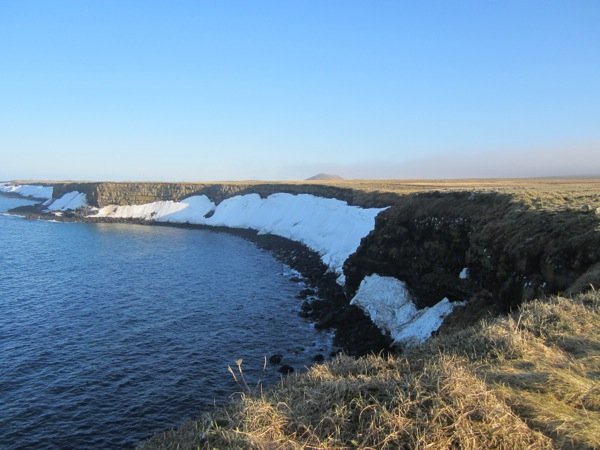
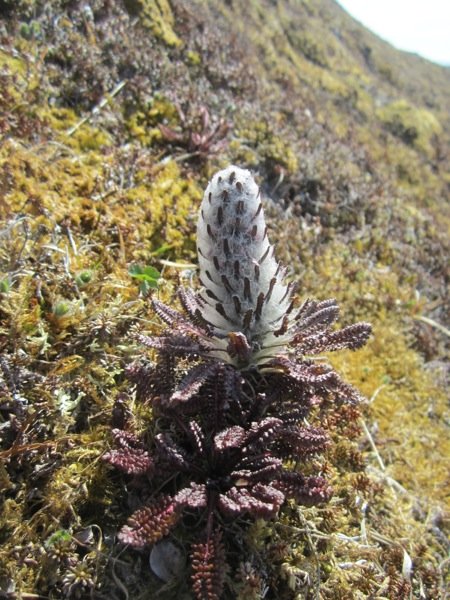
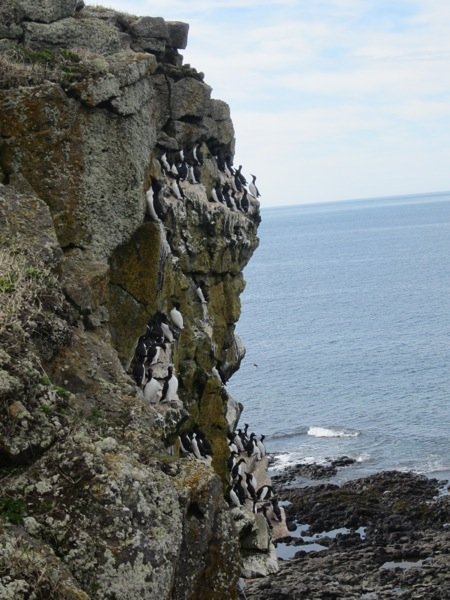
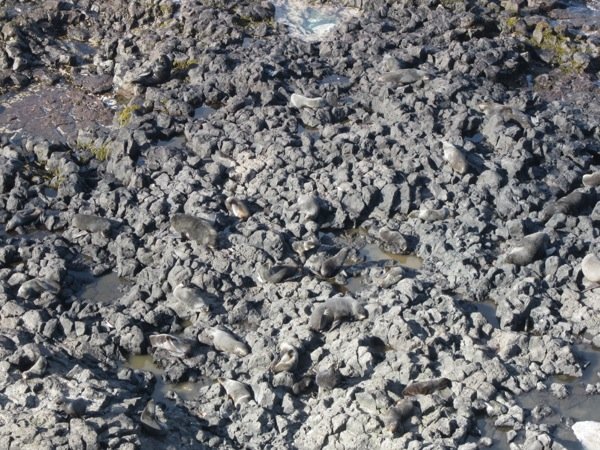
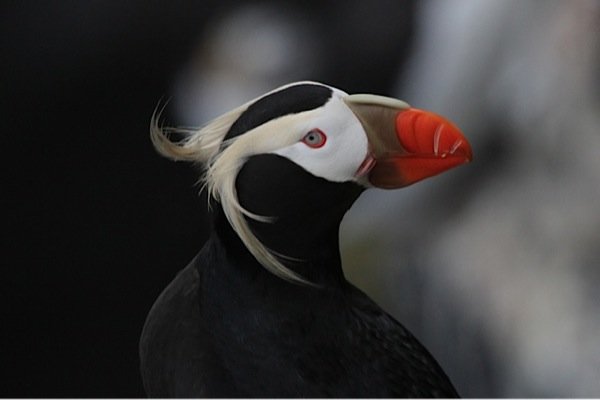
"Hey Mr. White Man, have a good life." The Filipino worker leaned over the staircase, cigarette in hand. He was calling out to the tall thin white man in front of me as we left the dining hall at the Trident Seafoods plant in St. Paul. St. Paul is a tiny island, one of two, along with St. George, which make up the Pribilof Islands in the Bering Sea. The Trident Seafood plant has the only food service on the island. So that is where we ate during the two days were were on the island.
The first time we walked in, the smell of fish smacked me upside the nostril. Interlaced with this was the tang of cigarette smoke. Once in the galley, the thickness of fried seafood took over. Our group of birders assembled meals from the salad bar and the range foods: rice, chicken, baked potatoes, and one night pasta, ravioli. The tomato soup was delicious; so was the carrot cake. We ate at long plastic tables, while a TV blared from one end of the room and a radio clattered from the kitchen. Everyone stared at the TV; no one spoke. The Trident workers, few of whom were white, ate in silence as well. They had just finished the crab season and a board in the hallway announced it was a good season: everyone would receive a $400 bonus.
"So Mr. White Man, where are you going from here?" I asked the young man. He had spent the past six months processing King Crab and was off to work in Wrangell processing salmon. "Today I got to see the seals for the first time," he said.
The seals are the Fur Seals. 1,000,000 Fur Seals migrate to the Pribilof Islands; in July, at the height of the breeding season, a seal pup is born every five seconds. While we were there, the males had arrived after months of swimming in the cold Bering Sea. We peered at them from blinds as they lolled on beaches or draped across the rocks. They were waiting for the "girls to show up," as one of our guides described it. Those females carry their babies for 11.8 months. So they arrive, give birth, then mate again before returning to the cold waters.
Our group spent our time at St. Paul watching all of the alcids that nest on the island, but also admiring those seals, which look like giant sausages on land. They would scratch with their flippers, and some would tangle with each other, but most just slept, the lazy sleep of an animal that has not been on land in months.
St. Paul is not an easy place to get to. We flew from Anchorage, stopping for fuel in Dillingham, and then flew on to St. George where some passengers deplaned. St. George is St. Paul's sister island, and is often shrouded in fog so few flights actually land. We got out of the plane under a cold blue sky and walked the airstrip. As we admired the views, cannons popped off in the background to set off the birds, which otherwise take over the runway. There, I saw Grey-crowned Rosy Finch, a large rose hued finch with a clean grey cap, and Red-legged Kittiwakes for the first time. I spoke with a woman who lives on the Island. She surfs offshore and that afternoon was going to kayak to the point. It seemed like a small paradise.
On the final leg of the journey I learned that the woman next to me was on her way to St. Paul to make it her home. Her young son and daughter sat in the seats behind us. Her husband was doing weather work on the island and had been living there since April. "I had some movies to see," she said with a laugh as a way to explain why she was only now arriving at her new home. "I'm not an island person."
St. Paul would be an interesting place to call home. There is a cluster of tidy houses, a Russian Orthodox Church and one store that sold 12 ounce bottles of water for $2.99 and four frozen cobs of corn for $13. There is some tourism on the island because though it is also frequently fogged in, it is more accessible. The island Native corporation (TDX) has also hired three young men, all fantastic birders, as guides to take visitors around. They greeted us at the airport, and walked us to our rooms at the King Eider Hotel. To call this a hotel is a bit of a stretch. The "hotel" is a hallway that runs parallel to the waiting room of the airport. Spare, clean rooms awaited us, with a bathroom down the hall. Through the night, the northern sun streamed through the thin curtains.
Right away we headed into the field to walk a marshy patch near town. An Arctic Fox worked the edges of the marsh, delighting all of us. The fox are so numerous, prowling the cliffs for birds or their eggs, that by the end of the trip we were less excited by them.
The land is low, dried grasses with a few wild flowers coming into bloom--buttercup and a fuzzy lousewort. I could see that by mid-summer the island would be a riot of color. And a riot of baby birds. The island is where a range of Alcids nest and they were all clamoring at the cliffs that ring the island. On the next day we walked the top of those cliffs, peering over at the ocean, then snow that still skirted the cliffs, a reminder of the winters in this exposed place. Birds speckled both the snowfields and the cliffs, often just feet away from us. Least and Parakeet Auklets, Horned and Tufted Puffins, all clung to the cliffs. Common Murres with their white bellies and black backs (which make them look like Northern Penguins) sit in a bunch while the Thick-billed Murres line up in a row, often with their backs to the water. In between these alcids both Black-legged and Red-legged Kittiwakes zoomed by, often carrying nesting material. All of the birds were enchanting, but the Tufted Puffin is a favorite, with those fantastic tufts, a movie star of a bird.
A few low hills rise up on the island, providing great views in all directions to lakes and to the Bering Sea. From these hills we also hoped to be able to scan the wide sky for a White-tailed Eagle that had been seen a few times on the island. We never saw the eagle, but during those eagle watches I was able to listen to the lively song of the Lapland Longspur, admire more Gray-crowned Rosy-finch and a few Snow Buntings.
During spring and fall, migrants are often blown off course, and they end up here on the island, hunkering down in the crab pots, or in some of the ditches around the island. One evening we drove the bumpy dirt road to the northern end of the island. We fanned out, walking to the top of a hill, when our guide emerged with a big grin. "Wilson's Warbler," he said a little out of breath. It's a bird all of us know well from our homes in the lower 48. But to see it there amidst birds that were exotic to us was an odd treat. We chased down hill, then I spied the bright bird, put my binoculars to my eyes to see its dark black cap, and vibrant yellow body. A piece of home in a place that felt like a stark and beautiful and hard place to call home. I wished that mother and her two kids luck in the new St. Paul lives; I wished all of those fur seals good breeding; I hoped the tall white man has a good salmon season.
photos: the cliffs of St. Paul; Wooley Lousewort; Murres on the cliffs; count all of the Fur Seals!; the elegant Tufted Puffin, photo by Peter Schoenberger